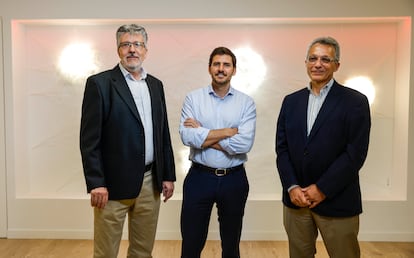Searching for an Alzheimer’s cure in a chicken’s eye
An idea from a Spanish researcher has become a gene therapy that will be tested on humans in 2026

Many medical breakthroughs — whose benefits are easy for anyone to grasp — begin with scientists asking questions that are difficult for most people to understand. The story of Tetraneuron, a company now aiming to develop a new treatment for Alzheimer’s, began with the curiosity of a researcher at the Cajal Institute of the Spanish National Research Council (CSIC) in Madrid.
José María Frade had spent years studying how the nervous system develops in embryos. While working on the study of the chicken retina during his postdoctoral research in Germany, he observed how neurons died when they attempted to reactivate their cell cycle — a process that normally only occurs during cell division and is both abnormal and lethal for adult neurons. Upon returning to Madrid, Frade set out to understand this strange mechanism and discovered the key role played by the transcription factor E2F4.
Under normal conditions, E2F4 regulates the cell cycle, helping to ensure that a cell does not divide when it shouldn’t. In adults, the cell cycle in neurons should remain switched off — but that changes under stress. In such situations, E2F4 receives a chemical tag (it becomes phosphorylated) and, like a switchboard getting wet, starts sending abnormal signals, reactivating the proliferation cycle of adult neurons. In this uncontrolled environment, the pathological cascade of Alzheimer’s begins, with the formation of beta-amyloid protein plaques in the brain, chronic inflammation, and the degeneration that leads to dementia.
A little over a decade ago, encouraged by the CSIC, Frade says he decided to file a patent based on ideas that had emerged from his research — a modified version of E2F4 (called E2F4-DN) designed to resist phosphorylation and thus block the reactivation of the cell cycle and the destruction of neurons.
“We proposed the use of this molecule to prevent diseases of the nervous system and other systems in which problems arise due to cell cycle reactivation and somatic proliferation,” Frade explains.
Later, Tetraneuron came about through a kind of serendipity, the kind that makes fascinating discoveries possible through unexpected connections. “It was completely by chance, when some entrepreneurs contacted me about another topic. I told them I had that patent, and that’s when I met the company’s founding partners, with whom we began this journey in 2012,” he recalls.
Until now, treatments for Alzheimer’s have focused on attacking beta-amyloid plaques and tau tangles that accumulate in the brain until they become toxic. The latest approved drugs, such as aducanumab or lecanemab, are monoclonal antibodies designed to bind to specific proteins in the body. In the case of Alzheimer’s, they bind to the proteins that form beta-amyloid plaques and help the immune system identify and eliminate them. Although these drugs have managed to reduce beta-amyloid levels by 20% to 30%, their ability to slow cognitive decline is very limited.
Tetraneuron proposes an alternative approach to traditional Alzheimer’s therapies. Their proposal is to restore neuronal function through gene therapy, with the potential not just to halt the disease but to reverse the damage already done. Like other gene therapies, it involves introducing a therapeutic gene into the body using a modified, harmless virus as a vehicle. In this case, the gene is a special version of E2F4 (E2F4-DN), designed to resist the enzymes that disrupt its role in maintaining neuronal balance. The treatment is administered via an injection into the cisterna magna, a cavity at the base of the skull that allows the therapy to reach the brain directly. Once inside, the therapeutic gene remains permanently active, with no need for repeat dosing. Results in mice have been positive.
To move forward on the difficult path from basic science to a treatment that improves patients’ lives, Tetraneuron brought on Álvaro Pascual-Leone, Professor of Neurology at Harvard Medical School, who was drawn by the originality of Frade’s idea.
“We know that neurodegenerative diseases develop at a certain point in life, but they are not caused by aging per se, nor are they obligatory consequences of being 65, 75, or 85,” says Pascual-Leone, who was recently appointed medical director of Tetraneuron.
The expert argues that aging and life events trigger changes in the body that activate genes capable of initiating disease. Some of these changes affect transcription factors like E2F4, which is where Tetraneuron’s proposal comes in. “By acting on these factors, you can reverse the pathological changes that have occurred, and that is radically revolutionary,” he says. “Now the challenge is how to demonstrate this in humans without compromising patient safety.”
For Frade, the most important finding from the animal experiments is the recovery of synaptic plasticity in the brain, which is key to memory formation. “That leads us to believe we’ll be able to reverse the disease,” he says. Pascual-Leone adds: “If you restore that capacity, you restore the brain’s ability to recreate memories, and since the circuits aren’t completely destroyed but are functionally disconnected, in principle, we’re talking about recovering the person.”
Ángel Lucio, the CEO of Tetraneuron, is aware of the challenge that lie ahead in reaching patients after the basic research phases and animal experiments are completed. “Gene therapy will be very expensive, and it will be a challenge to see how these types of therapies can be applied to prevalent diseases like Alzheimer’s,” he explains.
Currently, gene therapies are typically used for rare diseases, which may only affect a few dozen people. For now, Tetraneuron plans to target patients with moderate to severe Alzheimer’s, with more advanced deterioration than the early-stage patients eligible for current therapies that aim to slow disease progression. “And also, they should be patients who are within an age range where their health isn’t too compromised,” Lucio emphasizes.
The CEO also mentions another major challenge: producing the therapy at a scale large enough to make its use viable: “Even if the theory works, we’ll have to see if we’re able to target a sufficient number of neurons in a human brain, which weighs 1.3 kilos, as we have managed to do in a mouse, which has a brain of 0.42 grams. Although we have achieved a good level of expression of the therapy in monkeys, which have brains 140 times larger than those of a mouse, the leap to humans remains a significant technical challenge,” explains Frade.
According to Lucio, the company plans to administer its treatment to humans in the third quarter of 2026, after completing regulatory phases and finalizing ongoing primate trials. Fourteen years after the company was founded and more than two decades after Frade’s initial discoveries, Tetraneuron will finally be able to see whether its therapy is effective against a disease for which science so far has only managed very modest victories.
Sign up for our weekly newsletter to get more English-language news coverage from EL PAÍS USA Edition
Tu suscripción se está usando en otro dispositivo
¿Quieres añadir otro usuario a tu suscripción?
Si continúas leyendo en este dispositivo, no se podrá leer en el otro.
FlechaTu suscripción se está usando en otro dispositivo y solo puedes acceder a EL PAÍS desde un dispositivo a la vez.
Si quieres compartir tu cuenta, cambia tu suscripción a la modalidad Premium, así podrás añadir otro usuario. Cada uno accederá con su propia cuenta de email, lo que os permitirá personalizar vuestra experiencia en EL PAÍS.
¿Tienes una suscripción de empresa? Accede aquí para contratar más cuentas.
En el caso de no saber quién está usando tu cuenta, te recomendamos cambiar tu contraseña aquí.
Si decides continuar compartiendo tu cuenta, este mensaje se mostrará en tu dispositivo y en el de la otra persona que está usando tu cuenta de forma indefinida, afectando a tu experiencia de lectura. Puedes consultar aquí los términos y condiciones de la suscripción digital.
More information
Archived In
Últimas noticias
Maduro pleads not guilty before the federal court in New York: ‘I am still the president of Venezuela’
A new test can detect Alzheimer’s from a finger prick
UN team enters Sudanese city of El Fasher after paramilitary massacre: ‘It’s like a ghost town’
A recipe for resistance: Indigenous peoples politicize their struggles from the kitchen
Most viewed
- Gilles Lipovetsky: ‘If you want to live better and fall in love, take Prozac, don’t look to philosophy’
- Alain Aspect, Nobel laureate in physics: ‘Einstein was so smart that he would have had to recognize quantum entanglement’
- Alvin Hellerstein, a 92-year-old judge appointed by Bill Clinton, to preside over Maduro’s trial in New York
- Maduro’s downfall puts China’s relationship with Venezuela to the test
- Why oil has been at the center of Venezuela-US conflicts for decades










































